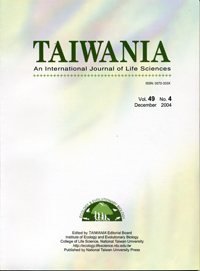Research Paper
Reproductive Behavior and Inbreeding Depression in Endangered Eremostachys superba Royle ex Benth. (Labiatae) in Dehra Dun Population, India
Arti Garg
Published on: December 2004
Page: 237 - 249
DOI: 10.6165/tai.2004.49(4).237
Abstract
An assessment of reproductive behavior and inbreeding depression, if any, in critically endangered Eremostachys superba Royle ex Benth. (Labiatae) was made to unveil the factors playing vital role in it’s reproductive biology and which may be responsible for the loss of fitness, viability and vigor of the species. Breeding experiments portrayed a failure of self-fertilization and a strong tendency towards out-breeding as seed set by xenogamy was highest (44.4%). However, the narrow restricted population of the type locality in Dehra Dun Siwaliks was just a ramet population sustained by clonal propagation of rhizomatous root stock, hence any out-crossing within these homozygous individuals also amounted to inbreeding. Further, there is no other population available within the range of normal seed dispersal mechanism or insect-pollinator-flight-range. The other populations reported are only from geographically distant region of Jammu and Kashmir state of India, which is too far a distance to be covered by the Nomia rustica West. and Ceratina heiroglyphica Sm., the oligophilic pollinators of E. superba, hence any crossing taking place also amounts to selfing in strict sense. Chances of induction of genetic variation by crossing between two different populations are remote. This was also supported by the data of seed production and germination experiments. Even the healthy seeds suffered from loss of fitness and failed to germinate under natural conditions. This strongly indicated prevalence of inbreeding depression and loss of fitness of the progeny right from the stage of germination, a phenomenon hazardous for sustenance and perpetuation of species leading to rarity.
中文摘要
本研究針對唇形科瀕危植物Eremostachys superba Royle ex Benth.進行生殖行為與近交衰敗之探討,以顯示在其生殖生物學上所扮演之角色,並討論這些因子是否與該植 物適應性,生存能力與活力的缺失有關。在授粉實驗中,自交成功的比例極低,而異株授粉的結種子率為最高(44.4%),顯示可能具有外交的傾向。然而由於該植物在Dehra DunSiwaliks 的生育區域極為狹小,且多由無性繁殖方式繁衍其族群,故在此近均質的個體間的交配,也幾乎等同於自交。這是由於在其傳粉者的飛行距離,與正常狀況下種子的可傳播範圍內,都沒有任何其他同種植物的族群存在。該植物另外的族群產於印度的Jammu 和Kashmir 州,都遠超過它僅知的傳粉者Nomia rustica West.和Ceratina heiroglyphica Sm.的飛行距離。本研究中種子產量與發芽的結果也同樣支持這個論述。即使是外觀健康的種子,在自然狀況下也無法正常發芽。這些結果顯示該植物極可能受到自交衰敗的影響而喪失適應性,對於該瀕危植物族群的維持顯然有高度的嚴重性。
Keyword: Labiatae, Eremostachys superba, Inbreeding depression, Autogamy, Geitonogamy, Xenogamy


